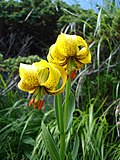Monocotyledons (/ˌmɒnəˌkɒtəˈliːdənz/), commonly referred to as monocots, (Lilianae sensu Chase & Reveal) are grass and grass-like flowering plants (angiosperms)...
115 KB (11,098 words) - 16:43, 22 August 2024
The monocots (or monocotyledons) are one of the two major groups of flowering plants (or Angiosperms), the other being the dicots (or dicotyledons). In...
27 KB (3,139 words) - 11:50, 5 April 2024
This page's list covers the monocotyledon plants found in Great Britain and Ireland. This clade includes grasses, lilies, orchids, irises and a wide variety...
36 KB (46 words) - 13:21, 6 July 2023
aerial portions of the plant. The cotyledon of grasses and many other monocotyledons is a highly modified leaf composed of a scutellum and a coleoptile....
13 KB (1,311 words) - 13:43, 30 June 2024
modern meaning of all the flowering plants including Dicotyledons and Monocotyledons. The APG system treats the flowering plants as an unranked clade without...
79 KB (6,233 words) - 01:47, 30 August 2024
Family). It is considered synonymous (or nearly synonymous) with the name monocotyledon. Publication of the name is credited to Scopoli (in 1760): see author...
7 KB (675 words) - 22:54, 1 October 2023
pseudopetiole, a petiole like structure. Pseudopetioles occur in some monocotyledons including bananas, palms and bamboos. Stipules may be conspicuous (e...
113 KB (11,733 words) - 17:20, 30 August 2024
treated this as one of six subclasses within the class Liliopsida (=monocotyledons). It consisted of the following:[citation needed] subclass Commelinidae...
12 KB (837 words) - 13:13, 30 June 2024
the seed leaves, attached to the embryonic axis. There may be one (Monocotyledons), or two (Dicotyledons). The cotyledons are also the source of nutrients...
76 KB (9,441 words) - 02:30, 1 September 2024
Dicotyledon (section Comparison with monocotyledons)
within this group. The other group of flowering plants were called monocotyledons (or monocots), typically each having one cotyledon. Historically, these...
14 KB (784 words) - 09:04, 11 August 2024
The Poales are a large order of flowering plants in the monocotyledons, and includes families of plants such as the grasses, bromeliads, rushes and sedges...
12 KB (1,147 words) - 16:06, 2 July 2024
Gonystylus, Ramin Ulmaceae (Elm family) Ulmus, Elm Zelkova, Zelkova About 10 Monocotyledon families include trees. Asparagaceae (Asparagus family) Cordyline, Cabbage...
11 KB (703 words) - 12:17, 25 August 2024
assigned the order to the subclass Arecidae in the class Liliopsida (= monocotyledons). The Thorne system (1992) and the Dahlgren system assigned the order...
4 KB (403 words) - 21:13, 31 May 2024
Extinct in the wild (EW): 45 species Critically endangered (CR): 5,702 species Endangered (EN): 10,901 species Vulnerable (VU): 9,673 species ...
12 KB (948 words) - 07:28, 22 May 2024
Monocotyledon species found in Montana number at least 615. The Montana Natural Heritage Program has identified a number of monocot species as Species...
46 KB (3,668 words) - 18:25, 23 March 2024
the traditional sense) are paraphyletic because the group excludes monocotyledons. "Dicotyledon" has not been used as a botanic classification for decades...
39 KB (3,836 words) - 05:06, 22 July 2024
Triteleia is a genus of monocotyledon flowering plants also known as triplet lilies. The 16 species are native to western North America, from British...
8 KB (364 words) - 23:38, 31 December 2023
energy store. Plants which grow out one of these primordia are called monocotyledons, while those that grow out two are dicotyledons. The next stage is called...
103 KB (11,633 words) - 05:09, 23 August 2024
Grisebach, their botanical authority, in 1854 as Zingiberides, an order of monocotyledons, subdivided into two families, Scitamineae and Musaceae. Based on morphological...
48 KB (4,325 words) - 04:23, 8 April 2024
plant taxonomists have also used the rank of subphylum, for instance monocotyledons as a subphylum of phylum Angiospermae and vertebrates as a subphylum...
2 KB (174 words) - 10:47, 15 September 2023
distally ascending, reflexed (folded back), or lanceolate. Like many monocotyledons, the perianth is homochlamydeous, which is undifferentiated into separate...
255 KB (23,805 words) - 06:23, 24 August 2024
or from the hypocotyl rather than from the radicle of a germinating monocotyledon. adventive Introduced accidentally (usually referring to a weed). aerial...
344 KB (29,020 words) - 00:57, 30 August 2024
from the original on 6 November 2022. Retrieved 6 May 2022. herbaceous monocotyledons lack cambial secondary growth but may have tough leaves and hard, fibrous...
124 KB (12,849 words) - 17:47, 31 August 2024
of tissue that surrounds the radicle (the embryonic primary root) in monocotyledon seeds. During germination, the coleorhiza is the first part to grow...
2 KB (205 words) - 16:26, 27 March 2024
66), although the origin is unclear. Aquatic plants, especially the Monocotyledons, include a large number of polyploids. The induction of polyploidy is...
81 KB (8,829 words) - 02:44, 15 July 2024
analysis of rbcL sequences identifies Acorus calamus as the primal extant monocotyledon. Duvall 1993 Duvall, Melvin R.; Clegg, Michael T.; Chase, Mark W.; Clark...
18 KB (1,805 words) - 03:01, 29 June 2024
This is a list of plant genera that engage in myco-heterotrophic relationships with fungi. It does not include the fungi that are parasitized by these...
3 KB (258 words) - 20:21, 30 June 2024
Self-incompatibility: genetic mechanisms which prevent self-fertilization Reproduction Monocotyledon reproduction Grossenbacher D, Briscoe Runquist R, Goldberg EE, Brandvain...
14 KB (1,863 words) - 19:32, 14 August 2024
Retrieved 27 July 2015. Klaus Kubitzki (Editor) Flowering Plants. Monocotyledons: Lilianae (except Orchidaceae), p. 305, at Google Books Michael Hickey...
9 KB (872 words) - 16:37, 10 July 2024
The Medeoloideae (syn. Medeoleae) are a subfamily of monocotyledon perennial, herbaceous mainly bulbous flowering plants in the lily family, Liliaceae...
2 KB (112 words) - 19:25, 20 March 2024


























